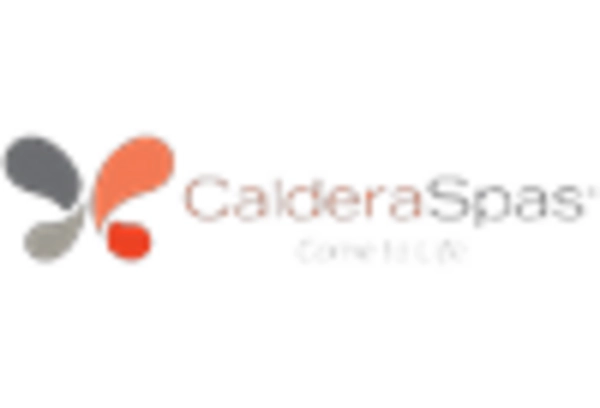Innovations in Hot Tub Technology
Technological advancements play a crucial role in shaping the Hot Tub Market. Innovations such as smart hot tubs equipped with app-controlled features, energy-efficient heating systems, and advanced water purification technologies are becoming increasingly popular. These enhancements not only improve user experience but also address environmental concerns by reducing energy consumption. Market data indicates that the integration of technology into hot tubs is attracting a younger demographic, who value convenience and modern features. As manufacturers continue to innovate, the Hot Tub Market is likely to see a shift in consumer preferences towards high-tech models, further driving market growth.
Expansion of Outdoor Living Spaces
The Hot Tub Market is benefiting from the ongoing trend of expanding outdoor living spaces. As homeowners invest in their backyards and patios, hot tubs are becoming a central feature in outdoor design. This trend is fueled by a desire for outdoor entertainment and relaxation, with many consumers viewing hot tubs as essential components of their outdoor lifestyle. Market data suggests that the demand for outdoor hot tubs has increased significantly, with many consumers opting for models that complement their outdoor aesthetics. This expansion of outdoor living spaces presents a substantial opportunity for the Hot Tub Market to cater to evolving consumer preferences.
Rising Awareness of Health Benefits
The Hot Tub Market is significantly influenced by the increasing awareness of the health benefits associated with hot tub usage. Research indicates that regular use of hot tubs can alleviate stress, improve sleep quality, and provide relief from muscle and joint pain. As consumers become more health-conscious, they are likely to invest in hot tubs as a means to enhance their well-being. The market data suggests that the demand for therapeutic hot tubs is on the rise, with a notable increase in sales of models designed specifically for health benefits. This trend underscores the potential for the Hot Tub Market to expand its reach among health-focused consumers seeking effective relaxation solutions.
Sustainability and Eco-Friendly Products
The Hot Tub Market is increasingly influenced by the demand for sustainability and eco-friendly products. Consumers are becoming more environmentally conscious, seeking hot tubs that utilize sustainable materials and energy-efficient technologies. Manufacturers are responding by developing eco-friendly hot tub options, which not only appeal to environmentally aware consumers but also align with broader sustainability initiatives. Market data indicates a growing segment of consumers willing to pay a premium for eco-friendly hot tubs, suggesting a shift in purchasing behavior. This trend highlights the potential for the Hot Tub Market to innovate and expand its offerings in response to consumer demand for sustainable solutions.
Increased Consumer Interest in Home Leisure Activities
The Hot Tub Market experiences a notable surge in consumer interest as individuals increasingly seek leisure activities within their homes. This trend is driven by a growing desire for relaxation and personal wellness, leading to a rise in hot tub purchases. According to recent data, the market is projected to grow at a compound annual growth rate of approximately 5.5 percent over the next several years. This growth is indicative of a broader shift towards home-based leisure solutions, as consumers prioritize comfort and convenience. The Hot Tub Market is thus positioned to benefit from this trend, as more households invest in outdoor living spaces that include hot tubs, enhancing their overall quality of life.

















Leave a Comment